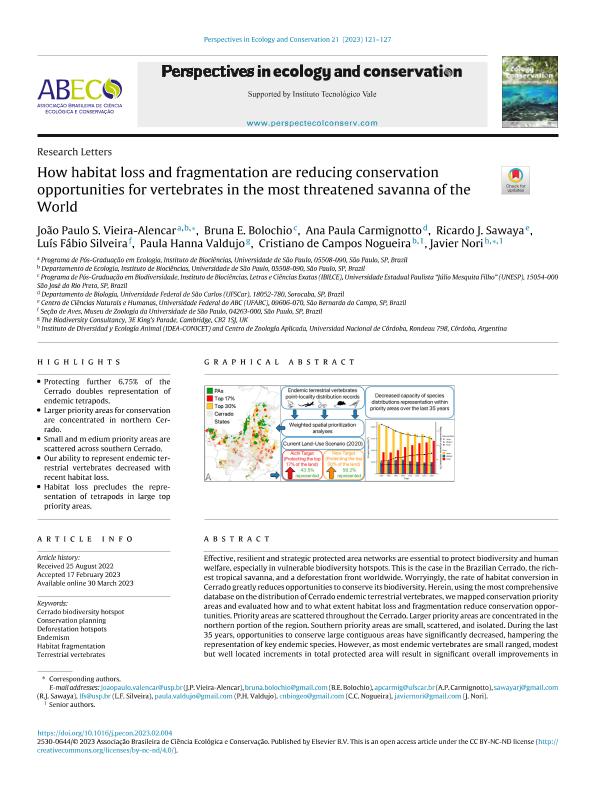Mostrar el registro sencillo del ítem
dc.contributor.author
Vieira Alencar, João Paulo S.
dc.contributor.author
Bolochio, Bruna E.
dc.contributor.author
Carmignotto, Ana Paula
dc.contributor.author
Sawaya, Ricardo J.
dc.contributor.author
Silveira, Luís Fábio
dc.contributor.author
Valdujo, Paula Hanna
dc.contributor.author
Nogueira, Cristiano de Campos

dc.contributor.author
Nori, Javier

dc.date.available
2024-03-07T12:08:49Z
dc.date.issued
2023-03
dc.identifier.citation
Vieira Alencar, João Paulo S.; Bolochio, Bruna E.; Carmignotto, Ana Paula; Sawaya, Ricardo J.; Silveira, Luís Fábio; et al.; How habitat loss and fragmentation are reducing conservation opportunities for vertebrates in the most threatened savanna of the World; Elsevier; Perspectives in Ecology and Conservation; 21; 2; 3-2023; 121-127
dc.identifier.issn
2530-0644
dc.identifier.uri
http://hdl.handle.net/11336/229656
dc.description.abstract
Effective, resilient and strategic protected area networks are essential to protect biodiversity and human welfare, especially in vulnerable biodiversity hotspots. This is the case in the Brazilian Cerrado, the richest tropical savanna, and a deforestation front worldwide. Worryingly, the rate of habitat conversion in Cerrado greatly reduces opportunities to conserve its biodiversity. Herein, using the most comprehensive database on the distribution of Cerrado endemic terrestrial vertebrates, we mapped conservation priority areas and evaluated how and to what extent habitat loss and fragmentation reduce conservation opportunities. Priority areas are scattered throughout the Cerrado. Larger priority areas are concentrated in the northern portion of the region. Southern priority areas are small, scattered, and isolated. During the last 35 years, opportunities to conserve large contiguous areas have significantly decreased, hampering the representation of key endemic species. However, as most endemic vertebrates are small ranged, modest but well located increments in total protected area will result in significant overall improvements in the PA system. Protecting the largest priority areas identified here is urgent and mandatory, while using habitat restoration as a key activity to promote connectivity among smaller priority areas, especially in the southern portion of this hotspot.
dc.format
application/pdf
dc.language.iso
eng
dc.publisher
Elsevier

dc.rights
info:eu-repo/semantics/openAccess
dc.rights.uri
https://creativecommons.org/licenses/by-nc-nd/2.5/ar/
dc.subject
Cerrado biodiversity hotspot
dc.subject
Conservation planning
dc.subject
Deforestation hotspots
dc.subject
Habitat fragmentation
dc.subject.classification
Conservación de la Biodiversidad

dc.subject.classification
Ciencias Biológicas

dc.subject.classification
CIENCIAS NATURALES Y EXACTAS

dc.title
How habitat loss and fragmentation are reducing conservation opportunities for vertebrates in the most threatened savanna of the World
dc.type
info:eu-repo/semantics/article
dc.type
info:ar-repo/semantics/artículo
dc.type
info:eu-repo/semantics/publishedVersion
dc.date.updated
2024-03-05T13:15:56Z
dc.journal.volume
21
dc.journal.number
2
dc.journal.pagination
121-127
dc.journal.pais
Brasil

dc.description.fil
Fil: Vieira Alencar, João Paulo S.. Universidade de Sao Paulo; Brasil
dc.description.fil
Fil: Bolochio, Bruna E.. Universidade de Sao Paulo; Brasil
dc.description.fil
Fil: Carmignotto, Ana Paula. Universidade de Sao Paulo; Brasil
dc.description.fil
Fil: Sawaya, Ricardo J.. Universidade de Sao Paulo; Brasil
dc.description.fil
Fil: Silveira, Luís Fábio. Universidade de Sao Paulo; Brasil
dc.description.fil
Fil: Valdujo, Paula Hanna. Universidade de Sao Paulo; Brasil
dc.description.fil
Fil: Nogueira, Cristiano de Campos. Universidade de Sao Paulo; Brasil
dc.description.fil
Fil: Nori, Javier. Consejo Nacional de Investigaciones Científicas y Técnicas. Centro Científico Tecnológico Conicet - Córdoba. Instituto de Diversidad y Ecología Animal. Universidad Nacional de Córdoba. Facultad de Ciencias Exactas Físicas y Naturales. Instituto de Diversidad y Ecología Animal; Argentina
dc.journal.title
Perspectives in Ecology and Conservation
dc.relation.alternativeid
info:eu-repo/semantics/altIdentifier/url/https://linkinghub.elsevier.com/retrieve/pii/S2530064423000184
dc.relation.alternativeid
info:eu-repo/semantics/altIdentifier/doi/http://dx.doi.org/10.1016/j.pecon.2023.02.004
Archivos asociados
